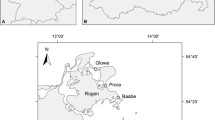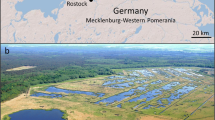Abstract
Although many studies have been conducted on the ecological functions and ecophysiological characteristics of lichen soil crusts (LSCs), no explanation of these results has been provided based on crust structures. Using algae soil crusts (ASCs) as comparison, this work studied the small-scale vertical distribution of algal biomass and stratification in two types of LSCs, by combining the binocular stereomicroscope observations, microscope observations, plate cultures, chlorophyll analysis, and polysaccharides analysis. The results showed an obvious difference in the proportion but not the composition of the algae species between the ASCs and the two LSCs. Approximately 60% and 80% of the total algal biomass were concentrated in the top 1 mm of the soil profile and thalli in the ASCs and LSCs, respectively. This implies that symbiotic algae are the dominant species and primary organic carbon producers in LSCs, and the algal biomass decreased with the depth in both the ASCs and LSCs. The small-scale vertical distributions of the crustal algal biomass and polysaccharides were characterized by obvious successional stage, whereas these were unrelated to the crust type within the successional stage. Additionally, a large amount of fungi, which were always piercing the entire crusts, were observed in the LSCs, but only occasionally in the ASCs. These special structures are purported to cause the LSCs to achieve specific ecological functions, such as higher carbon fixation and greater compressive strength. High biomass, large living space, and advantageous resource utilization privilege suggest that the lichen association is mutualistic and the direction from ASCs to LSCs is developmental.









Similar content being viewed by others
References
Belnap J (2001) Factors influencing nitrogen fixation and nitrogen release in biological soil crusts. In: Belnap J, Lange OL (eds) Biological soil crusts: structure, function, and management. Springer, Berlin, pp 241–261
Belnap J (2003) The world at your feet: desert biological soil crusts. Front Ecol Environ 1(5):181–189
Evans RD, Johansen JR (1999) Microbiotic crusts and ecosystem processes. Crit Rev Plant Sci 18:183–225
Evans RD, Belnap J (1999) Long-term consequences of disturbance on nitrogen dynamics in an arid ecosystem. Ecology 80:150–160
Verrecchia E, Yair A, Kidron GJ, Verrecchia K (1995) Physical properties of the psammophile cryptogamic crust and their consequences to the water regime of sandy softs, North-western Negev Desert, Israel. J Arid Environ 29:427–137
Hu CX, Liu YD, Zhang DL, Huang ZB, Paulsen BS (2002) Cementing mechanism of algal crusts from desert area. Chin Sci Bull 47(16):1361–1368
Eldridge DL, Greene RSB (1994) Microbiotic soil crusts: a review of their roles in soil and ecological processes in the rangelands of Australia. Aust J Soil Res 32:389–415
Zaady E, Gutterman Y, Boeken B (1997) The germination of mucilaginous seeds of Plantago coronopus, Reboudia pinnata, and Carrichtera annua on cyanobacterial soil crust from the Negev Desert. Plant Soil 190:247–252
Harper KT, Belnap J (2001) The influence of biological soil crusts on mineral uptake by associated vascular plants. J Arid Environ 47:347–357
Lalley JS, Viles HA, Henschel JR, Lalley V (2006) Lichen-dominated soil crusts as arthropod habitat in warm deserts. J Arid Environ 67:579–593
Redfield E, Barns SM, Belnap J, Daane LL, Kuske CR (2002) Comparative diversity and composition of cyanobacteria in three predominant soil crusts of the Colorado Plateau. FEMS Microbiol Ecol 40:55–63
Hu CX, Liu YD, Song LR, Zhang DL (2002) Effect of desert soil algae on the stabilization of fine sands. J Appl Phycol 14:281–292
Evans RD, Lange OL (2001) Biological soil crusts and ecosystems nitrogen and carbon dynamics. In: Belnap J, Lange OL (eds) Biological soil crusts: structure, function, and management. Springer, Berlin, pp 263–279
Belnap J (2002) Nitrogen fixation in biological soil crusts from southeast Utah, USA. Biol Fertil Soils 35:128–35
Clair LLS, Johansen JR (1993) Introduction to the symposium on soil crust communities. Great Basin Nat 53:1–4
Eldridge DJ (1999) Distribution and floristics of moss- and lichen-dorminanted soil crusts in a patterned Callitris glaucophylla woodland in eastern Australia. Acta Oecol 20(3):159–170
Eldridge DJ (1996) Distribution and floristics of terricolous lichens in soil crusts in arid semi-arid New South Wales, Australia. Aust J Bot 44:223–247
Fernando TM (2003) Small-scale spatial patterns of two soil lichens in semi-arid Mediterranean steppe. Lichenologist 35(1):71–81
Garcia-Piche F, Belnap J (1996) Microenvironments and microscale productivity of cyanobacterial desert crusts. J Phycol 32:774–782
Garcia-Pichel F, Johnson SL, Youngkin D, Belnap J (2003) Small-scale vertical distribution of bacterial biomass and diversity in biological soil crusts from arid lands in the Colorado Plateau. Microb Ecol 46:312–321
Hu CX, Zhang DL, Huang ZB, Liu YD (2003) The vertical microdistribution of cyanobacteria and green algae within desert crusts and the development of the algal crusts. Plant Soil 257:97–111
Stal LJ (2000) Cyanobacterial mat and stromatolites. In: Whitton BA, Potts M (eds) The ecology of cyanobacteria: their diversity in time and space. Kluwer Academic, Dordrecht, pp 61–120
Liu YD, Ley SH (1989) Species composition and distribution of blue-green algae in rice field soils, Hubei, China. Nova Hedwig 48(1/2):55–67
Garcia-Pichel F, Pringault O (2001) Microbiology: cyanobacteria track water in desert soils. Nature 413:380–381
Pringault O, Garcia-Pichel F (2004) Hydrotaxis of cyanobacteria in desert crusts. Microbial Ecol 47:366–373
Wintermans JFGM, De Mots A (1965) Spectrophotometric characteristics of chlorophylls a and b and their pheophytins in ethanol. Biochim Biophys Acta 109:448–453
Dubois M, Gilles KA, Hamilton JK, Rebers PA, Smith F (1956) Colorimetric method for determination of sugars and related substances. Anal Chem 28:350–356
Gauslaa Y, Solhaug KA (2001) Fungal melanins as a sun screen for symbiotic green algae in the lichen Lobaria pulmonaria. Oecologia 126:462–471
Sinha RP, Richter P, Faddoul J, Braun M, Donat-P H (2002) Effects of UV and visible light on cyanobacteria at the cellular level. Photochem Photobiol Sci 1:553–559
Lan SB, Wu L, Zhang DL, Hu CX, Liu YD (2011) Ethanol outperforms multiple solvents in the extraction of chlorophyll-a from biological soil crusts. Soil Biol Biochem. doi:10.1016/j.soilbio.2010.12.007
Hu HJ, Li RY, Wei YX, Zhu HZ, Chen JY, Shi ZX (2006) The freshwater algae of China. Shanghai Science and Technology Press, Beijing (in Chinese)
Lange OL, Kilian E, Ziegler H (1986) Water vapor uptake and photosynthesis of lichens: performance differences in species with green and blue-green algae as phycobionts. Oecologia 71:104–110
Wynn-Williams DD (2000) Cyanobacteria in deserts—life at the limit? In: Whitton BA, Potts M (eds) The ecology of cyanobacteria: their diversity in time and space. Kluwer Academic, Dordrecht, pp 341–336
Belnap J, Phillips SL, Witwickia DL, Miller ME (2008) Visually assessing the level of development and soil surface stability of cyanobacterially dominated biological soil crusts. J Arid Environ 72:1257–1264
Belnap J, Gardner JS (1993) Soil microstructure in soils of the Colorado Plateau: the role of the cyanobacterium Microcoleus vaginatus. Great Basin Nat 53(1):40–47
Hill DR, Keenan TW, Helm RF, Potts M, Crowe LM, Crowe JH (1997) Extracellular polysaccharide of Nostoc commune (Cyanobacteria) inhibits fusion of membrane vesicles during desiccation. J Appl Phycol 9:237–248
Lange OL, Green TGA, Melzera B, Meyera A, Zellnera H (2006) Water relations and CO2 exchange of the terrestrial lichen Teloschistes capensis in the Namib fog desert: measurements during two seasons in the field and under controlled conditions. Flora 201:268–280
Green TGA, Schlensog M, Sancho LG, Winkler BJ, Broom FD, Schroeter B (2002) The photobiont determines the pattern of photosynthetic activity within a single lichen thallus containing cyanobacterial and green algal sectors (photosymbiodeme). Oecologia 130:191–198
Lange OL, Belnap J, Reichenberger H (1998) Photosynthesis of the cyanobacteria soil-crust lichen: Collema tenax from arid lands in southern Utah, USA: role of water content on light and temperature responses of CO2 exchange. Funct Ecol 12:195–202
Palmqvist K, Campbell D, Ekblad A, Johansson H (1998) Photosynthetic capacity in relation to nitrogen content and its partitioning in lichens with different photobionts. Plant Cell Environ 21:361–372
Hill DJ (1993) The co-ordination of development of symbionts in mutualistic symbiosis with reference to the cell cycle of the photobiont in lichens. Symbiosis 14:1–3
Ahmadjian V, Jacobs JB (1981) Relationship between fungus and alga in the lichen Cladonia cristatella Ruck. Nature 289:169–172
Belnap J, Gillette DA (1998) Vulnerability of desert biological soil crusts to wind erosion: the influences of crust development, soil texture, and disturbance. J Arid Environ 39:133–142
Acknowledgments
We greatly acknowledged the help of Professor Liu Yongding. This work was supported by the National Natural Science Foundation of China (no. 30870470), the National Principal Expert Program (2008ZX07103-004; 2009ZX07106-001-003) and the National Basic Research Programs of China (no: 2008CB418001).
Author information
Authors and Affiliations
Corresponding author
Rights and permissions
About this article
Cite this article
Wu, L., Lan, S., Zhang, D. et al. Small-Scale Vertical Distribution of Algae and Structure of Lichen Soil Crusts. Microb Ecol 62, 715–724 (2011). https://doi.org/10.1007/s00248-011-9828-5
Received:
Accepted:
Published:
Issue Date:
DOI: https://doi.org/10.1007/s00248-011-9828-5




